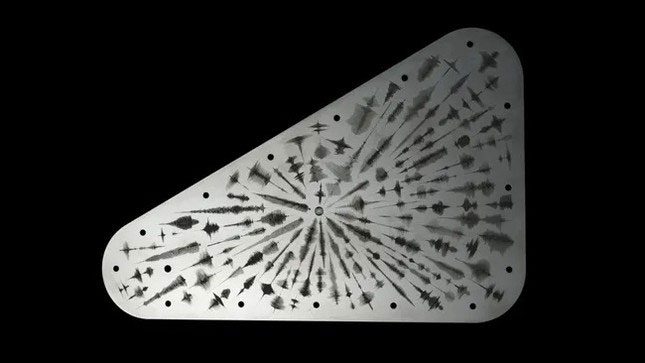From a poem written by an award-winning American poet to millions of names etched on a disc, NASA’s Europa Clipper mission will leave a lasting mark of humanity.
NASA has unveiled the human message that will be sent on its latest mission to Jupiter’s icy moon, Europa.
In 2023, NASA launched a campaign called “Message in a Bottle”, inviting millions of people to sign a message that will be sent across the solar system aboard the Europa Clipper spacecraft.
The launch of the Europa Clipper spacecraft is scheduled for October 2024 and is part of a mission to explore whether the subsurface regions of Europa can support life.

One side of the commemorative disc that will be sent to Europa in October 2024. The disc will be attached to the Europa Clipper spacecraft and includes a microchip containing the names of over 2.6 million people. (Image: NASA/JPL-Caltech).
In a recent statement, NASA revealed the names that will be sent into space. More than 2.6 million names have been etched onto a “coin-sized” silicon microchip by technicians at the Microdevices Laboratory at NASA’s Jet Propulsion Laboratory. This microchip will be attached to a commemorative disc, which features a handwritten copy of the poem “Ode to Mystery: A Poem for Europa” by award-winning American poet Ada Limón.
The disc measures approximately 18 x 28 cm and is made of tantalum metal, adorned on both sides with artwork that “highlights the connection between Earth and Europa,” NASA stated in the announcement.
If any life is found on Europa, it is likely to be microbial, making this commemorative disc more symbolic than a message to extraterrestrial beings.
Lori Glaze, director of the Planetary Science Division at NASA, stated: “The content and design of the disc are very meaningful. The disc combines the best of what humanity has to offer the universe—science, technology, education, art, and mathematics. The message of connection through water perfectly illustrates the bond with Earth.”
The Decades-Long Journey of the Europa Clipper Spacecraft
The intricate design features of the disc pay homage to this scientific pursuit and the connection between Earth and Europa. For instance, the outward-facing panel contains waveforms, a visual representation of sound waves, derived from recordings of speakers saying “water” in 103 different languages. The interior of the disc includes visual references to radio frequencies that could be used for interstellar communication.
Robert Pappalardo, project scientist at NASA’s Jet Propulsion Laboratory, said: “This is a decades-long journey, and we are eagerly looking forward to seeing what the Europa Clipper will reveal about this water world.”
After a long journey of 1.8 billion miles through space, the Clipper is expected to begin orbiting Jupiter in 2030. From there, it plans to make approximately 49 flybys of Europa. Scientists hope to utilize the mission to gather data from beneath Europa’s ocean, which contains twice the amount of water found in all of Earth’s oceans, as well as data from the icy crust, thin atmosphere, and the moon’s environmental conditions.
Europa, one of Jupiter’s moons, has long been considered one of the most promising candidates in the search for extraterrestrial life; however, newly released data from NASA’s Juno mission suggests that Europa may lack the oxygen necessary to support life, somewhat dampening these hopes. Upcoming observations by the Europa Clipper will help clarify these uncertainties.


















































